Overview
When renting a grinder for your construction project, it is crucial to first evaluate your specific requirements, including the type of material, area size, depth of grind, and power source. Following this assessment, conduct thorough research on local rental companies and online platforms to check for availability and pricing. Understanding these factors is essential; it not only helps you select the most suitable grinder but also aids in avoiding unexpected costs or issues during your project. By carefully reviewing rental agreements, you can ensure a smooth rental experience that meets your project needs.
Key Highlights:
- Assess the type of material to be ground (e.g., concrete or asphalt) to select the appropriate grinder.
- Measure the area needing grinding to determine the size and power of the machine required.
- Identify the necessary depth of grind, which can vary based on project needs.
- Choose between electric or gas-powered grinders based on job site conditions and operational costs.
- Research local rental companies and online platforms for availability and pricing.
- Review customer feedback to evaluate the reliability of rental services.
- Prepare a list of questions regarding specifications, rental rates, and additional fees before contacting rental companies.
- Discuss lease terms, including duration, payment options, and deposit requirements.
- Request a detailed quote that includes all associated costs for comparison.
- Coordinate pickup times with the rental company to align with project schedules.
- Inspect the grinder for damage before accepting it and ensure you understand its operation.
- Review the rental agreement thoroughly, focusing on terms, liability, insurance requirements, and potential hidden fees.
Introduction
Navigating the world of construction equipment rentals can be a daunting task, particularly when selecting the right grinder for your project. With the growing demand for efficient grinding solutions, understanding how to effectively rent a grinder is crucial for achieving optimal results.
What steps should you take to ensure that the chosen grinder meets specific project requirements while avoiding common pitfalls? This guide delves into the essential steps for renting a grinder, providing valuable insights that can lead to a smoother and more successful construction experience.
Identify Your Grinder Requirements
To effectively rent a grinder for your construction project, begin by assessing the scope of work. Consider the following critical factors:
- Type of Material: Identify whether you will be grinding concrete, asphalt, or another material. Each mill is specifically designed for certain surfaces, impacting performance and results. As industry expert Andy Bulson emphasizes, selecting the appropriate mill is essential for maximizing efficiency and achieving your desired output.
- Size of the Area: Measure the area requiring grinding. For larger areas, more powerful or larger machines may be necessary to ensure efficiency and effectiveness. The global floor polishing equipment rental market is projected to rise from USD 299.6 million in 2023 to USD 460.8 million in 2033, underscoring the increasing demand for efficient grinding solutions.
- Depth of Grind: Determine the required depth of grinding. Some projects may only need a light surface grind, while others might require deeper cuts to achieve the desired finish.
- Power Source: Assess whether an electric or gas-powered tool is more appropriate based on your job site’s power availability. Electric tools are often favored for indoor use due to their reduced noise levels and lack of exhaust emissions. According to Bulson, electric appliances can significantly lower long-term operational costs, making them a budget-friendly choice for fixed-location applications.
By clearly outlining these necessities, you can simplify your choices and select the most suitable tool for your task. Additionally, ensure that you have a solid return policy established when you rent a grinder, allowing for effortless exchanges if the grinder does not meet your expectations. Understanding the specific requirements of your endeavor is crucial for enhancing efficiency and achieving optimal outcomes.
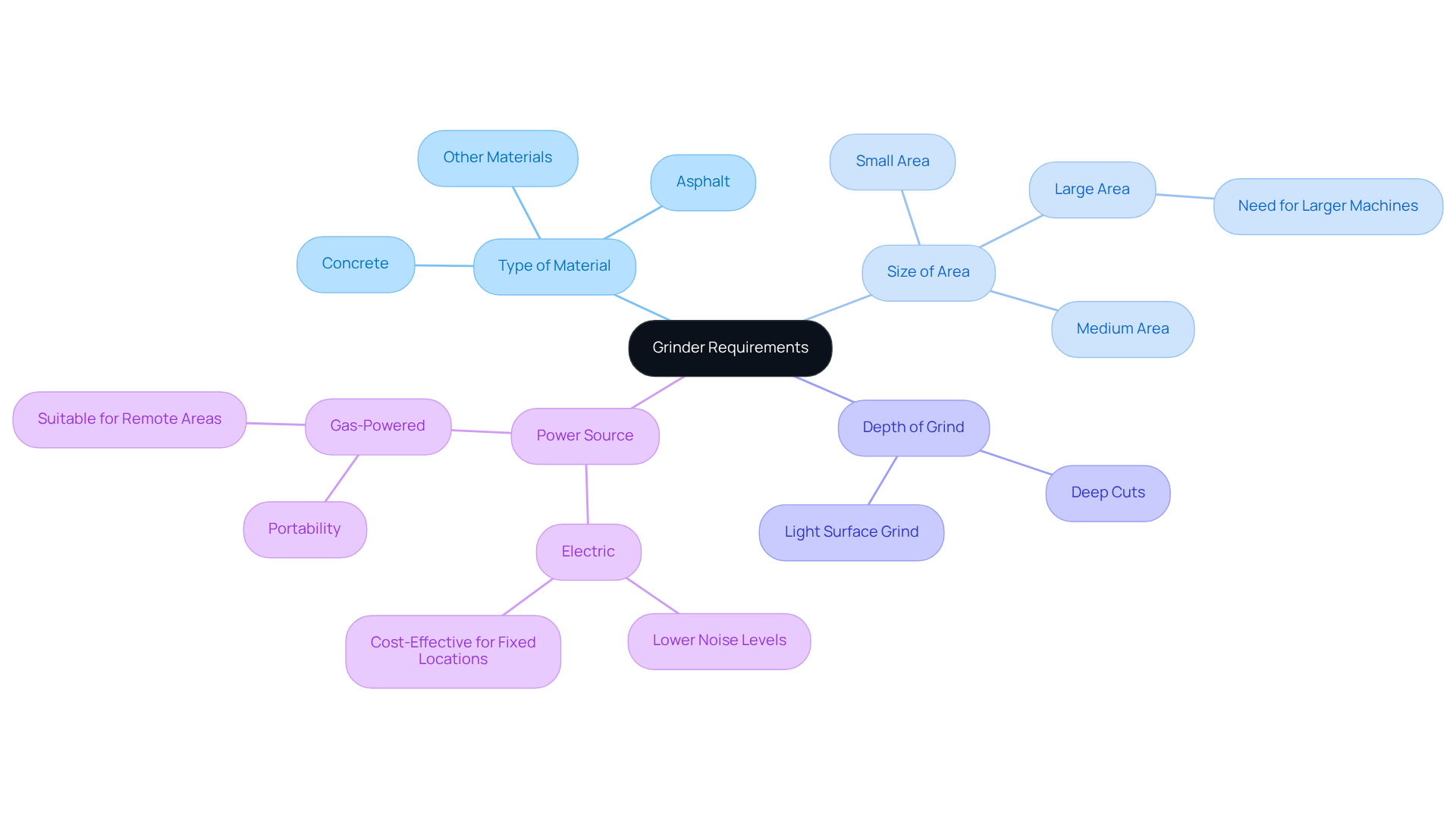
Research Rental Options
To effectively rent a grinder for your construction project, it is essential to start by clearly defining your specific requirements. Once you have established your needs, explore the following avenues for rental options:
- Local Rental Companies: Investigate reputable equipment rental companies in your vicinity, such as EZ Equipment Rental. This company is known for its extensive selection of construction equipment and commitment to quality service. EZ Equipment Rental has established itself as a leading provider in the DFW metro area, emphasizing customer satisfaction and reliability.
- Online Platforms: Utilize online leasing platforms to compare prices and availability. Websites like Home Depot and United Rentals provide comprehensive listings of grinders, allowing you to assess various options conveniently. Notably, the machinery leasing market was valued at USD 122,925.12 million in 2024 and is anticipated to reach USD 180,787.8 million by 2032, indicating a rising need for leasing services.
- Customer Feedback: Review customer evaluations and testimonials to assess the dependability and service excellence of various leasing companies. Positive feedback can indicate a trustworthy provider. As John McClelland, ARA vice president, remarked, "more than half of the tools that exist in the United States are rental items," emphasizing the significance of selecting a trustworthy rental service.
- Equipment Condition: Always inquire about the state of the machines available for rent. Ensuring that the equipment is well-maintained and appropriate for your requirements is crucial for optimal performance.
By conducting a comprehensive investigation through these avenues, you can confidently choose the optimal option to rent a grinder for your machine, ensuring it fulfills your task specifications efficiently.
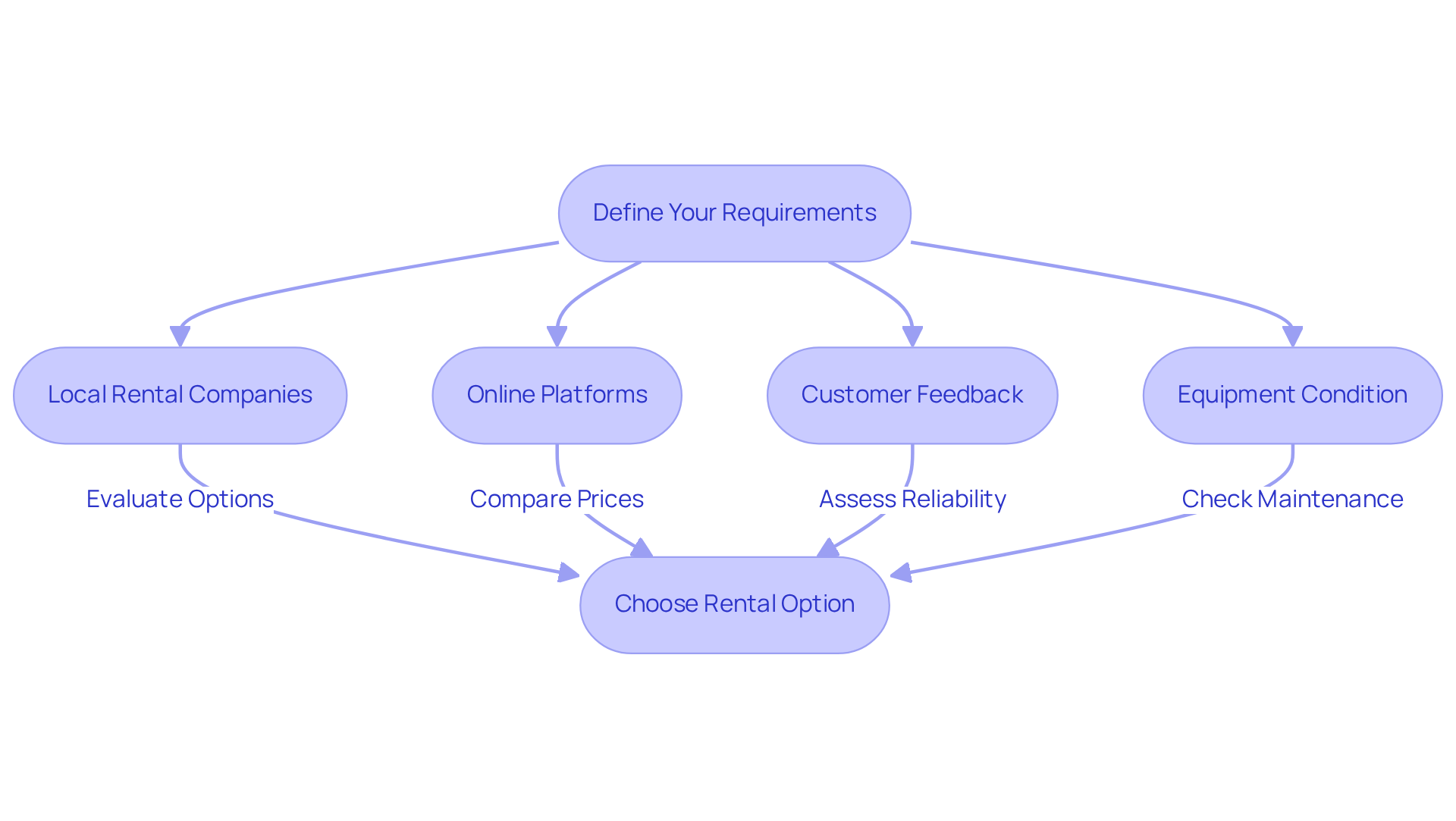
Contact Rental Companies
After narrowing down your options, it is essential to reach out to the companies where you can rent a grinder.
Prepare Questions: Before contacting them, compile a list of essential questions regarding the grinder's specifications, rental rates, and any additional fees, such as delivery or insurance. Construction project managers frequently inquire about the machinery's horsepower, weight, and compatibility with specific tasks to ensure it meets project requirements. This preparation lays the groundwork for effective communication.
Inquire about the availability to rent a grinder for your preferred booking dates. Given the anticipated expansion in the U.S. construction machinery leasing market, with an expected CAGR of 4.73% from 2022 to 2029, prompt communication is vital to secure the resources you require. Being proactive in this step can significantly influence the success of your project.
Discuss lease terms by inquiring about the duration, payment options, and any deposit requirements before deciding to rent a grinder. Understanding the conditions of the leasing agreement is crucial, particularly as 40.2% of fleet managers have indicated rising maintenance budgets to prolong equipment lifespan, underscoring the importance of dependable equipment. Clear terms can prevent misunderstandings down the line.
Request a Quote: Obtain a detailed estimate that includes all expenses associated with the option to rent a grinder, allowing for effective comparison with other options. This step is essential as the U.S. construction and general tool leasing industry was valued at $83.3 billion in 2024, reflecting a competitive market. A comprehensive quote ensures you are making an informed decision.
Effective communication will assist you in collecting all essential information to make a knowledgeable choice, ensuring that your endeavor runs smoothly and efficiently.
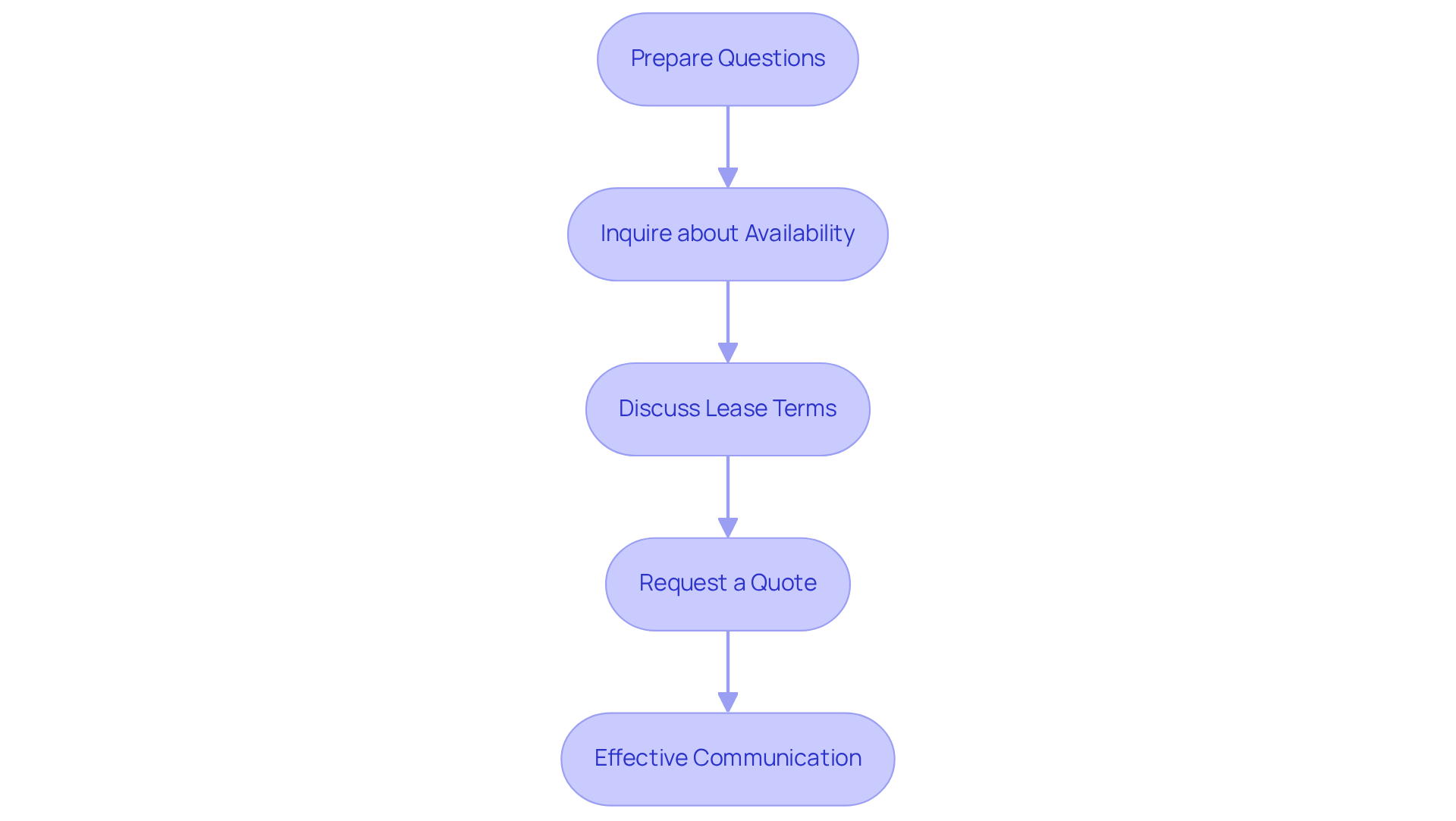
Arrange Equipment Pickup
Once your rental is confirmed, it is crucial to arrange for equipment pickup effectively.
Schedule Pickup: Coordinate with the rental company to set a pickup time that aligns with your project schedule, ensuring minimal disruption.
Documentation: Prepare all necessary paperwork, including a valid ID, the lease agreement, proof of insurance, and a credit card for security purposes. Having these documents ready will streamline the pickup process.
- Inspect the equipment: Upon arrival, thoroughly inspect the grinder for any visible damage or missing parts before you decide to rent a grinder. It is essential to inform the leasing company of any problems before departing to prevent liability. As Josh Nickell, CEO of Northside Tool Rentals, emphasizes, "Understanding the state of the tools before you leave is vital to ensure you are not held responsible for pre-existing issues."
Ask for Instructions: If you are unfamiliar with the tools, request a brief demonstration or guidance from the rental staff on safe operation practices. For example, always wear appropriate personal protective equipment (PPE) and follow the manufacturer's guidelines for operation.
By adhering to these steps, you can facilitate a smooth pickup process and be well-prepared to commence your project on schedule.
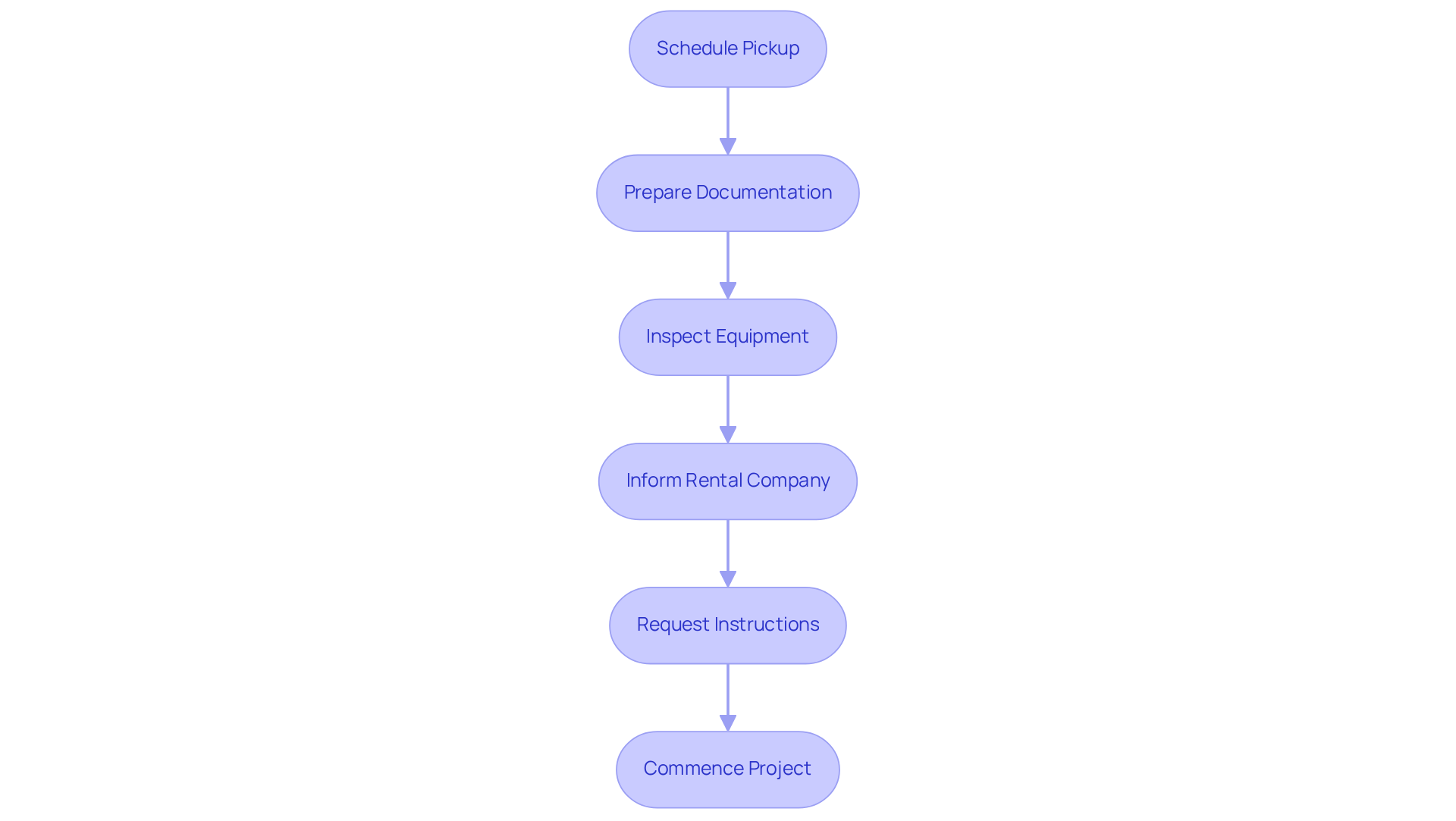
Review Rental Agreements
Before finalizing your rental, it is crucial to meticulously review the rental agreement to avoid common pitfalls.
Read the Terms: Scrutinize the rental duration, fees, and any penalties associated with late returns or damages. Understanding these details can prevent unexpected costs and ensure a smoother rental process.
Understand Liability: Clearly define who is responsible for repairs or damages that may arise during the leasing period. This clarity is essential to avoid disputes later and to protect your interests.
Check for Insurance Requirements: Many leasing firms mandate insurance for the equipment. Familiarize yourself with these requirements to ensure compliance and protect your interests. According to legal experts, having adequate insurance coverage can safeguard you against potential liabilities, making it a vital aspect of your rental agreement.
Ask Questions: If any part of the agreement is unclear, do not hesitate to seek clarification from the leasing company. Open communication can help prevent misunderstandings and foster a positive relationship with the provider.
Identify common pitfalls when you rent a grinder: Be aware of specific issues related to grinder leasing, such as hidden fees for additional accessories or maintenance responsibilities that may not be clearly outlined in the agreement. Understanding these factors will help you navigate the rental landscape more effectively.
Key Terms to Look For: Pay attention to key terms in the lease agreement, including 'indemnification,' 'hold harmless,' and 'force majeure,' as these can significantly impact your responsibilities and liabilities.
By thoroughly reviewing the rental agreement, you can mitigate potential issues and ensure a seamless rental experience, ultimately contributing to the success of your construction project.
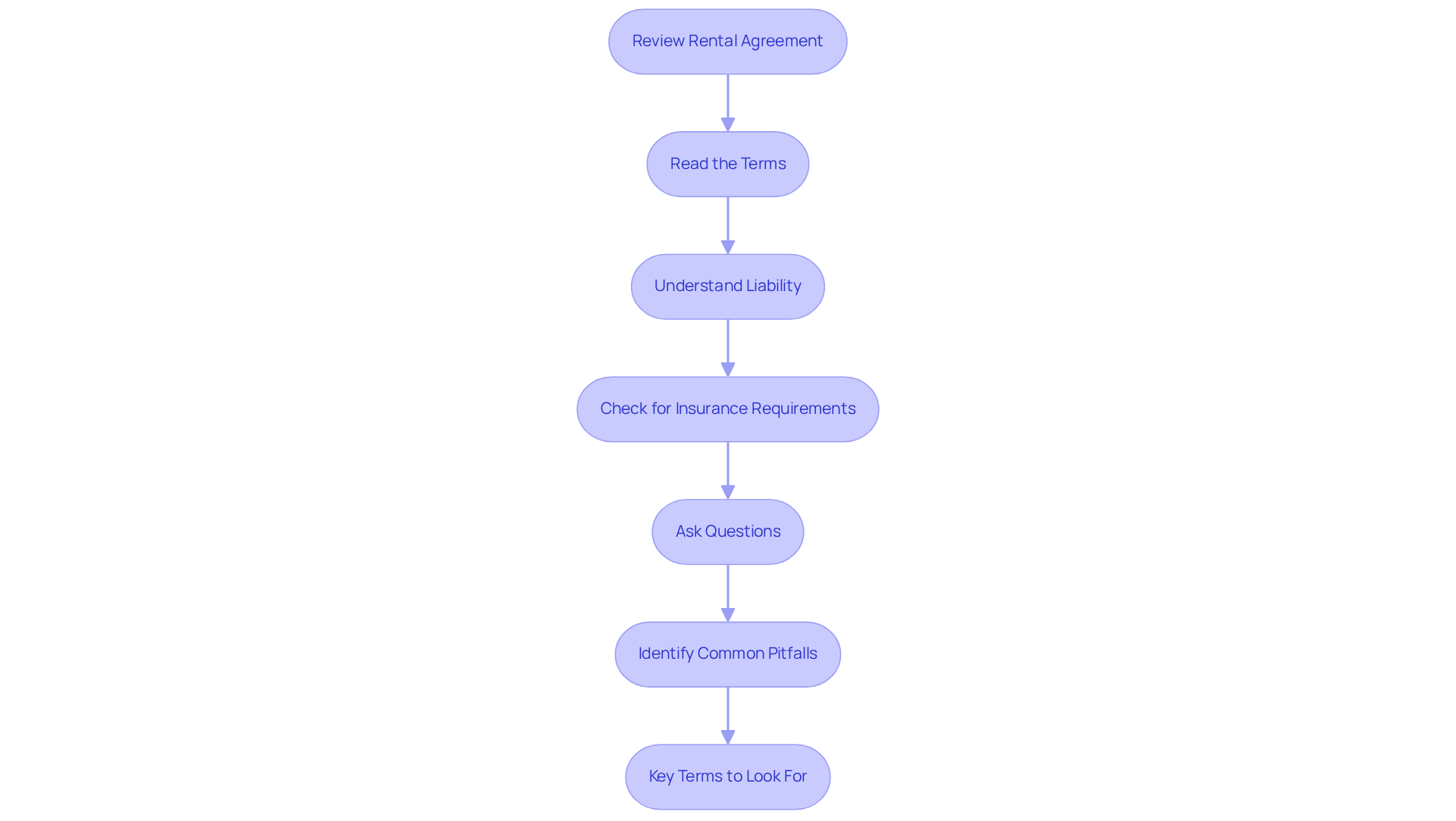
Conclusion
Renting a grinder for a construction project demands a methodical approach to ensure the right equipment is selected for the job. Understanding specific requirements, researching rental options, contacting companies for quotes, arranging equipment pickup, and reviewing rental agreements are essential steps that streamline the process and enhance project efficiency.
Key considerations include:
- Identifying the type of material to be ground
- The size and depth of the area
- The necessary power source
Engaging with reputable rental companies and utilizing online platforms can provide valuable insights and comparisons. Furthermore, clear communication with rental providers ensures that all necessary details are addressed. A meticulous review of rental agreements helps avoid pitfalls and clarifies responsibilities.
Ultimately, dedicating time to these steps not only promotes a successful rental experience but also contributes significantly to the overall success of the construction project. By being informed and proactive, one can secure the right grinder and optimize performance, leading to quality results and satisfied stakeholders.
Frequently Asked Questions
What factors should I consider when identifying my grinder requirements?
When identifying your grinder requirements, consider the type of material you will be grinding (e.g., concrete or asphalt), the size of the area needing grinding, the required depth of grind, and the power source (electric or gas-powered) based on your job site's power availability.
Why is it important to select the appropriate grinder for my project?
Selecting the appropriate grinder is essential for maximizing efficiency and achieving desired results, as different grinders are designed for specific surfaces and tasks.
How can the size of the area impact my choice of grinder?
For larger areas, more powerful or larger machines may be necessary to ensure efficiency and effectiveness in completing the grinding task.
What is the significance of the depth of grind in selecting a grinder?
The depth of grind determines whether you need a light surface grind or a deeper cut, which influences the type of grinder you should rent.
What are the advantages of using electric tools for grinding?
Electric tools are often favored for indoor use due to their reduced noise levels and lack of exhaust emissions. They can also lower long-term operational costs, making them a budget-friendly choice for fixed-location applications.
Where can I find rental options for grinders?
You can find rental options through local rental companies, online leasing platforms like Home Depot and United Rentals, and by reviewing customer feedback and testimonials about various leasing companies.
What should I look for when researching rental companies?
Look for reputable equipment rental companies, assess customer evaluations and testimonials, inquire about the condition of the machines available for rent, and ensure the company has a commitment to quality service.
Why is it important to check the condition of the rented equipment?
Ensuring that the rented equipment is well-maintained and suitable for your requirements is crucial for optimal performance and achieving the desired outcomes.




